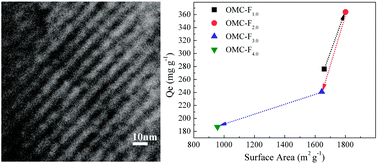Tuned surface area and mesopore diameter of ordered mesoporous carbon: ultrahigh decontamination of di(2-ethylhexyl)phthalate
Abstract
Synthesis of carbon materials with enhanced surface areas, and regular and tuned pore diameters is always a great challenge. In this report, ordered mesoporous carbons (OMCs) were synthesized by the one-step assembly of tri-constituents, and the OMCs were applied as an adsorbent for the removal of the highly hazardous water pollutant di(2-ethylhexyl)phthalate (DEHP). Phloroglucinol–formaldehyde based carbon precursor was in situ prepared during the assembly of the tri-constituents, and the surface area and mesopore diameter of the OMCs were tuned by variation of the molar ratio of formaldehyde to phloroglucinol. Small angle X-ray diffraction patterns revealed that the obtained carbons are highly ordered, which is in agreement with the measuring results of transmission electron microscopy at low and high resolution. Scanning electron microscopy images demonstrate that OMC-F2.0 has a hierarchical morphology. Nitrogen adsorption–desorption measurements revealed that the surface area of the OMCs (956–1801 m2 g−1) was dependent on the molar ratio of the carbon precursor constituents (formaldehyde to phloroglucinol). By varying the molar ratio of formaldehyde to phloroglucinol from 1.0 to 4.0, the mesopore diameter of the OMCs was shifted to the higher side, from 2.1 to 3.1 nm. DEHP was efficiently removed from a model water pollutant by the OMCs. OMC-F2.0 achieved the highest adsorption capacity of 364 mg g−1 for the removal of DEHP. The adsorption equilibrium data were treated with the two mathematical models of Langmuir and Freundlich, and the results revealed that decontamination was more favorable with the Langmuir model. This concludes that the removal of DEHP by OMCs depends on the surface area, and the DEHP molecules occupied the porous space of the OMCs in a monolayer manner.


 Please wait while we load your content...
Please wait while we load your content...